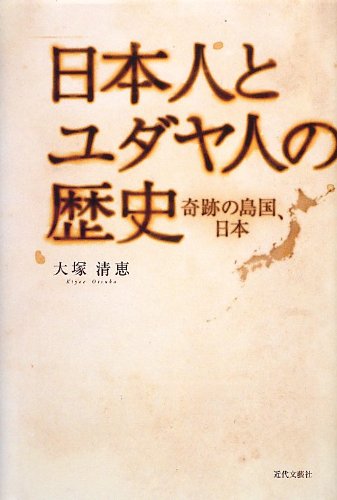18 0 0 0 IR 日本・イスラエル比較文化研究(2)日本列島は誰が創った?
- 著者
- 大塚 清恵 Otsuka Kiyoe
- 出版者
- 鹿児島大学
- 雑誌
- 鹿児島大学教育学部研究紀要 人文社会科学編 (ISSN:03896684)
- 巻号頁・発行日
- vol.61, pp.97-123, 2009
本稿は、鹿児島大学教育学部研究紀要(人文・社会科学編)第58 号に掲載された「日本・イスラエル比較文化研究 ―日猶同祖論考―」の続編である。一般的に「秦氏」と呼ばれる3 世紀末から5 世紀にかけて朝鮮半島から渡って来たシルクロード渡来人は、時代を超越した高度な知識と技術を持っていた。彼らは、古代日本に技術革命をもたらし、政治・宗教・生産活動・文化を大きく発展させた殖産豪族集団である。この論文は、古墳文化、飛鳥文化を築いた渡来人がイスラエル系であったことを詳述した後、なぜ突然彼らが大挙して極東の島国にやって来たのか?なぜ4 世紀から5 世紀にかけて一見無意味な巨大古墳を現在の大阪の地に築いたのか?なぜ北九州と畿内が秦氏の拠点なのか?なぜ全国各地に奇妙な三本鳥居の神社を建てたのか?という日本史の謎に対して大胆な一つの仮説を立てた。
11 0 0 0 IR 日本・イスラエル比較文化研究--日猶同祖論考
- 著者
- 大塚 清恵
- 出版者
- 鹿児島大学
- 雑誌
- 鹿児島大学教育学部研究紀要 人文社会科学編 (ISSN:03896684)
- 巻号頁・発行日
- vol.58, pp.127-146, 2006
The ancient kingdom of Israel, which consisted of 12 tribes, was in circa 922 B.C. divided into the southern kingdom of Judah and the northern kingdom of Israel. 10 tribes out of the 12 belonged to the northern kingdom and the rest to the southern kingdom. The people of the northern kingdom were exiled to Assyria in 722 B.C. never to return to Israel. They are called the Ten Lost Tribes of Israel. They were dispersed all over the world. Their descendants are found not only in the western world, but also in the eastern world especially along the Silk Road. Japan and Israel are geographically far from each other and seemingly unrelated nations. However, the two nations are remarkably similar in mythology, religious rituals, language, daily customs, etc. Some of the Japanese and Jewish scholars who are conversant with the ancient cultures of Japan and Israel claim that numerous striking similarities between the two cultures are proofs indicating that the Ten Lost Tribes of Israel came to ancient Japan. The purpose of this paper is to examine the authenticity of their claim by making a comparisonof the ancient cultures of Japan and Israel, which may help solve some of the cultural riddles of Japan such as why Japanese like rectangles or why Japanese have numbers in their names.
8 0 0 0 日本人とユダヤ人の歴史 : 奇跡の島国、日本
6 0 0 0 OA 日本・イスラエル比較文化研究 : 日猶同祖論考
- 著者
- "大塚 清恵"
- 出版者
- 鹿児島大学
- 雑誌
- "鹿児島大学教育学部研究紀要. 人文・社会科学編=Bulletin of the Faculty of Education, Kagoshima University. Cultural and social science"
- 巻号頁・発行日
- vol.58, pp.127-146, (Released:2016-10-27)
"The ancient kingdom of Israel, which consisted of 12 tribes, was in circa 922 B.C. divided into the southern kingdom of Judah and the northern kingdom of Israel. 10 tribes out of the 12 belonged to the northern kingdom and the rest to the southern kingdom. The people of the northern kingdom were exiled to Assyria in 722 B.C. never to return to Israel. They are called the Ten Lost Tribes of Israel. They were dispersed all over the world. Their descendants are found not only in the western world, but also in the eastern world especially along the Silk Road. Japan and Israel are geographically far from each other and seemingly unrelated nations. However, the two nations are remarkably similar in mythology, religious rituals, language, daily customs, etc. Some of the Japanese and Jewish scholars who are conversant with the ancient cultures of Japan and Israel claim that numerous striking similarities between the two cultures are proofs indicating that the Ten Lost Tribes of Israel came to ancient Japan. The purpose of this paper is to examine the authenticity of their claim by making a comparisonof the ancient cultures of Japan and Israel, which may help solve some of the cultural riddles of Japan such as why Japanese like rectangles or why Japanese have numbers in their names."
6 0 0 0 OA 男女間の諸問題に関する大学生の意識調査
- 著者
- 大塚 清恵
- 出版者
- 鹿児島大学
- 雑誌
- 鹿児島大学教育学部研究紀要. 人文・社会科学編 (ISSN:03896684)
- 巻号頁・発行日
- vol.56, pp.103-121, 2005-03-25
16年前(1988年)から鹿児島大学の共通教育において女性学講座を開いている。ジェンダー・フリー時代が到来し「女らしさ・男らしさ」が問い直されている今,大学生のジェンダー学への関心は高く,鹿児島大学の女性学講座も毎年50人〜300人の学生が受講している。この調査報告は過去2年間400人の受講生を対象に行ったアンケート結果に基づいている。調査内容は,一般・家庭・政治・教育・労働・性・法律・心理の八項目にわたり,調査対象とした学生の学部比率は工学部(37%),法文学部(28%),農学部(10%),理学部(7%),医学部(7%),教育学部(6%),水産学部(3%),歯学部(1%)であった。この論文では,全体の65%を占める工学部と法文学部の回答者の中から100人ずつ無作為抽出し,そのアンケート結果を男女別に分けて集計し性別比較分析を行った。調査対象者の数が少ないので,統計学的客観性は低いと思うが,アンケート分析から最近の鹿児島大学生の男女間の諸問題および性役割に対する考えを多少は浮き彫りにできると思う。今後も5年ごとに同じ調査をし,鹿児島大学生の男女関係に問する意識の変化を追っていきたいと思う。
3 0 0 0 IR 日本・イスラエル比較文化研究(2) ―日本列島は誰が創った?―
- 著者
- 大塚 清恵
- 出版者
- 鹿児島大学
- 雑誌
- 鹿児島大学教育学部研究紀要. 人文・社会科学編 = Bulletin of the Faculty of Education, Kagoshima University. Cultural and social science (ISSN:03896684)
- 巻号頁・発行日
- vol.61, pp.97-123,
本稿は、鹿児島大学教育学部研究紀要(人文・社会科学編)第58 号に掲載された「日本・イスラエル比較文化研究 ―日猶同祖論考―」の続編である。一般的に「秦氏」と呼ばれる3 世紀末から5 世紀にかけて朝鮮半島から渡って来たシルクロード渡来人は、時代を超越した高度な知識と技術を持っていた。彼らは、古代日本に技術革命をもたらし、政治・宗教・生産活動・文化を大きく発展させた殖産豪族集団である。この論文は、古墳文化、飛鳥文化を築いた渡来人がイスラエル系であったことを詳述した後、なぜ突然彼らが大挙して極東の島国にやって来たのか?なぜ4 世紀から5 世紀にかけて一見無意味な巨大古墳を現在の大阪の地に築いたのか?なぜ北九州と畿内が秦氏の拠点なのか?なぜ全国各地に奇妙な三本鳥居の神社を建てたのか?という日本史の謎に対して大胆な一つの仮説を立てた。
2 0 0 0 IR グリーン・ツーリズムの教育的価値--「農」がニート青年を甦らせる
- 著者
- 大塚 清恵
- 出版者
- 鹿児島大学
- 雑誌
- 鹿児島大学教育学部研究紀要. 人文・社会科学編 (ISSN:03896684)
- 巻号頁・発行日
- vol.57, pp.85-102, 2005
現在,日本でサステーナブル・ツーリズム(持続可能な観光)として注目されているグリーンツーリズム(農山漁村滞在型観光)は,ニート青年を立ち直らせるオータナティブ教育として,また都会の子供たちに自然や食べ物のありがたさを体験をとおして学ばせる食育として注目を集めている。この論文では,日本の観光史を概説しニート問題を心理面から分析した後,グリーンツーリズムが都会育ちの若者や子供たちを活性化することに成功したいくつかの事例を紹介する。
1 0 0 0 OA 日本・イスラエル比較文化研究(2) ―日本列島は誰が創った?―
- 著者
- 大塚 清恵
- 出版者
- 鹿児島大学
- 雑誌
- 鹿児島大学教育学部研究紀要. 人文・社会科学編 = Bulletin of the Faculty of Education, Kagoshima University. Cultural and social science (ISSN:03896684)
- 巻号頁・発行日
- vol.61, pp.97-123, (Released:2016-10-28)
本稿は、鹿児島大学教育学部研究紀要(人文・社会科学編)第58 号に掲載された「日本・イスラエル比較文化研究 ―日猶同祖論考―」の続編である。一般的に「秦氏」と呼ばれる3 世紀末から5 世紀にかけて朝鮮半島から渡って来たシルクロード渡来人は、時代を超越した高度な知識と技術を持っていた。彼らは、古代日本に技術革命をもたらし、政治・宗教・生産活動・文化を大きく発展させた殖産豪族集団である。この論文は、古墳文化、飛鳥文化を築いた渡来人がイスラエル系であったことを詳述した後、なぜ突然彼らが大挙して極東の島国にやって来たのか?なぜ4 世紀から5 世紀にかけて一見無意味な巨大古墳を現在の大阪の地に築いたのか?なぜ北九州と畿内が秦氏の拠点なのか?なぜ全国各地に奇妙な三本鳥居の神社を建てたのか?という日本史の謎に対して大胆な一つの仮説を立てた。

